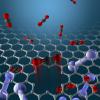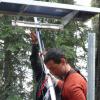Climate & Environment
- <p>The University of Colorado at Boulder has been awarded $1.4 million for a new study on how changes in land use, forest management and climate may affect trans-basin water diversions in Colorado and other semi-arid regions in the western United States.</p>
 Engineering faculty and students at the University of Colorado Boulder have produced the first experimental results showing that atomically thin graphene membranes with tiny pores can effectively and efficiently separate gas molecules through size-selective sieving. The findings are a significant step toward the realization of more energy-efficient membranes for natural gas production and for reducing carbon dioxide emissions from power plant exhaust pipes.
Engineering faculty and students at the University of Colorado Boulder have produced the first experimental results showing that atomically thin graphene membranes with tiny pores can effectively and efficiently separate gas molecules through size-selective sieving. The findings are a significant step toward the realization of more energy-efficient membranes for natural gas production and for reducing carbon dioxide emissions from power plant exhaust pipes.- <p> </p>
<p>Engineering faculty and students at the University of Colorado Boulder have produced the first experimental results showing that atomically thin graphene membranes with tiny pores can effectively and efficiently separate gas molecules through size-selective sieving.</p>
<p>The findings are a significant step toward the realization of more energy-efficient membranes for natural gas production and for reducing carbon dioxide emissions from power plant exhaust pipes.</p> - Leading quantitative conservation biologist named CU’s first Colorado Chair in Environmental Studies<p>The University of Colorado Boulder has hired its first Colorado Chair in Environmental Studies, an endowed chair awarded to Daniel Doak, a conservation biologist known for his quantitative analysis of how different government policies could affect the populations of species ranging from sea otters, California condors, corals and rare plants.</p>
<p>The endowed chair in environmental studies was made possible by $4 million in gifts made anonymously in 2009 and 2010 toward the chair. </p> - <p><span>A University of Colorado Boulder-led mission to explore and understand how the loss of atmospheric gas has changed the climate of Mars over the eons has been authorized by NASA to proceed to system delivery, spacecraft integration, testing and launch, which is slated for November 2013.</span></p>
 <p>A new University of Colorado Boulder-led study that ties forest “greenness” in the western United States to fluctuating year-to-year snowpack indicates mid-elevation mountain ecosystems are most sensitive to rising temperatures and changes in precipitation and snowmelt.</p>
<p>A new University of Colorado Boulder-led study that ties forest “greenness” in the western United States to fluctuating year-to-year snowpack indicates mid-elevation mountain ecosystems are most sensitive to rising temperatures and changes in precipitation and snowmelt.</p>- <p>A new University of Colorado Boulder-led study that ties forest “greenness” in the western United States to fluctuating year-to-year snowpack indicates mid-elevation mountain ecosystems are most sensitive to rising temperatures and changes in precipitation and snowmelt.</p>
- <p>The National Oceanic and Atmospheric Administration has selected the University of Colorado Boulder to continue a federal/academic partnership that extends NOAA’s ability to study climate change, improve weather models and better predict how solar storms can disrupt communication and navigation technologies.</p>
<p><span id="">The selection means that NOAA will continue funding the Cooperative Institute for Research in Environmental Sciences, or CIRES, for at least five years and up to 10 more years. CIRES was established at CU-Boulder in 1967.</span></p> - <p>When the Fourmile Canyon Fire erupted west of Boulder in 2010, smoke from the wildfire poured into parts of the city including a site housing scientists from the University of Colorado Boulder’s Cooperative Institute for Research in Environmental Sciences and the National Oceanic and Atmospheric Administration.</p>
- <p> </p>
<p>The blanket of sea ice floating on the Arctic Ocean melted to its lowest extent ever recorded since satellites began measuring it in 1979, according to the University of Colorado Boulder’s National Snow and Ice Data Center.</p>


